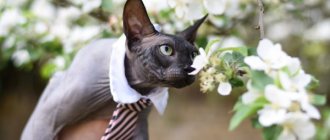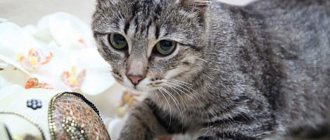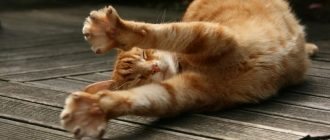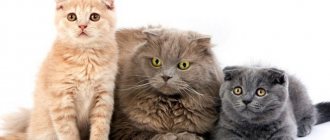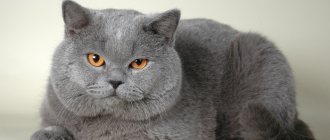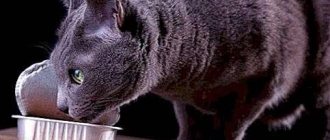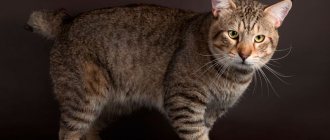Now we’ll tell you which cat breeds are the most evil.
The leading and at the same time permanent place in the ranking of the Top 10 evil cat breeds belongs to Siamese cats, terrible jealous cats and hunters.
You wouldn’t guess from the angelic blue eyes and beautiful coloring that the owner of cute features is vengeful, holds a grudge for a long time and is capable of inflicting reprisals on the offender at the most inopportune moment.
Oriental
Oriental cats are next on the list of the most evil breeds. They are very capricious, selfish, deciding everything and always for the whole world. They are fast and energetic, they do not like being forced to be affectionate or being ignored. If you don't notice their ears, you risk getting a depressed cat in the house who will behave vindictively and disrespectfully, marking in slippers and making marks on wallpaper and furniture.
The Siberian cat is independent and proud, not tolerant of affection.
The Siberian cat has a fairly large build with a fluffy face and thick hair. It is believed that this breed originated from the crossing of a domestic cat with wild species of the cat family. The weight of the female reaches 6 kg, and the weight of the male can reach 12 kg.
The character is very independent. The Siberian cat does not like unexpected displays of affection from its owners.
Read the full review of the large cat breed - Siberian.
Maintenance and care
In keeping, outbred cats are very unpretentious.
They are practically omnivorous and there are no problems with feeding. It is important that the diet is balanced. You can feed your cat dry or canned industrial food, which already contains all the necessary microelements
Or choose natural food.
In this case, the menu is compiled individually based on the preferences and needs of the pet. The cat's diet should include meat and offal (liver, lungs, heart), vegetables and grains (oats, wheat, barley), and dairy products. Use mineral and vitamin supplements if necessary. Remember that food from your table will not replace your pet’s proper nutrition.
The cat's food should be tasty, the bowl should be clean and the water should be fresh.
Your cat should always have access to clean water. Interestingly, cats are more likely to drink if food and water are in different places.
Up to six months, a kitten needs to be fed at least 4 times a day. At 6 months, switch to 2 meals a day. If your pet does not suffer from greed and is not prone to obesity, you can practice free feeding. It is necessary to ensure that the bowl is clean and the food is fresh.
Remove discharge from the eyes with a soft cloth. Train your kitten to use a scratching post. This will save you and your cat from the unpleasant procedure of trimming its claws. You need to bathe your pet as soon as it gets dirty. But not often. Cats take care of their fur coats themselves. Almost everyone, with rare exceptions, does not like water procedures.
READ How to name a black kitten boy
When choosing a toilet for a kitten, focus on an adult cat, so as not to buy a new one when it grows up. The pet must enter it entirely. The height of the sides is not lower than 6 cm. It is better to use clumping filler for the tray. It absorbs odor well and simplifies the cleaning process. If finances allow, then the best option would be a box (dry toilet) with replaceable cassettes.
Snow Shu
A breed called Snow Shoe is not very widespread. This is due to their restlessness, which makes them want to hunt for something or someone, play pranks, and having received punishment, hide and take revenge on a harmful person. Cats - “snowflakes” are smart, can open locks and doors, manage, scatter and hide small change.
Owners say that when Snow Shu raises his voice, he can hit a loud person with his paw. So, think three times before getting such a pet.
London in touch
In fact, London has nothing to do with it. But the British Shorthair is included in the ranking of the most evil cats. And you can’t say this at all, looking at the round face with wide open eyes. The British have a unique character. They do not tolerate disrespectful behavior towards them. These cats are generally not known for their patience. They are quite demanding and at the same time independent. Although the British breed is characterized as particularly attached to its owner.
Ural Rex
This breed first gained popularity in pre-war times. But after the war, the number of these cats decreased, and for a long time they were considered to have disappeared forever.
But in the 60s, it became known about Ural Rex breeders, and the myth about the disappearance of the breed was dispelled, although the breed is still considered quite rare.
People who buy a handsome Ural cat most often think about its unusual appearance, but do not think at all about the unpredictable nature of this cat.
Most often, such cats behave quite friendly and affectionately, but at any moment the cat’s behavior can change in a sharply negative direction . So owners and their guests should beware of sudden bites from their pet.
Bengal
Another representative of the evil cat family is the Bengal, with a pronounced hunting instinct and incredibly impressive appearance. Many of the representatives of the Bengal breed have impulsive character traits, due to which the animal becomes aggressive, capable of even attacking the owner in case of contradictions.
Raising your voice, much less shouting, is not tolerated. Day after day, Bengals tirelessly drive everywhere, and this continues until old age. Not everyone will like this. If the owner does not want to get a pet that will constantly attack him, he needs maximum attention, affection and care for the representatives of the breed.
Causes of aggressive behavior
You can try to tame any angry cat and turn it into an affectionate pet.
This can only be done if you bring him into the house as a baby and surround him with maximum attention and care. But still, bursts of aggression may appear in his character
It is much more difficult to train an adult animal.
A cat's behavior can change dramatically at any time. A situation often arises: a pet was affectionate and kind, but suddenly its gaze became angry and aggressive. Changes in mood can be due to several reasons:
- the cat recently became a mother and is now trying to protect her offspring from people passing by;
- hormonal surges occur in the pet’s body, due to which he feels discomfort;
- pain caused by illness, injury or surgery;
- stress that appeared after moving, rearranging the premises, renovation, or if the owners decided to have another individual in the house;
- hunger or thirst;
- mental disorder.
Note! Cats often behave aggressively if several pets live in the same room. This is how they try to win back their territory.
Features of aggression
Bombay cat - description of Bombay cats
It is easy to recognize the appearance of aggression in a cat of any breed. Characteristic signs include nervous tail wagging, ears pinned back to the head, dilated pupils and hissing.
The cat is hunting
You should also be wary of the fact that she is trying to hide or presses herself to the floor to attack her owner. For some time it is better not to approach her and not get into her field of vision. If such a problem arises, then you should not treat it negligently. As a result of this behavior, sleep disturbances, decreased immunity may occur, and ultimately, the cat will become very irritable and will not be able to control its aggression.
Ukrainian Levkoy – the superiority and grace of the breed borders on bright flashes of aggression
A characteristic feature of the Ukrainian Levkoy is an elongated, slightly flattened head, huge slanting eyes of soft blue or bright green. She has elegance and graceful curves of her body. The body is quite strong without hair.
The cat has high intellectual abilities. However, for all her devotion to her owner, she is very decisive and in times of danger can show aggression.
We offer you an article about the graceful but independent cat breed, the Ukrainian Levkoy.
Chausie
The chausie is also not of the kindest disposition; it is wild and capricious, slightly reminiscent of a puma in appearance. The chausie is distinguished by its size and highly developed hunting instinct. There is no place for them in a small apartment because of their large dimensions and desire to run around, their love of occupying mezzanine and above closet spaces, creating reserves and secret storage areas, which the owners will periodically access.
Abyssinian
The Abyssinian cat is an ancient breed. Her character resembles that of a dog. She is very active, playful, extremely energetic and easy to train. The Abyssinian has a hard time with loneliness and is prone to depression. Like representatives of the Siamese breed, Abyssinian cats can take revenge on household members for grievances caused. They can bite and scratch painfully.
Cathesian
Not the most common, but one that ranks among the top evil cat breeds is the Chartreuse or Cathesian. Cats of French origin are extremely jealous, considering themselves the only ones they love. They cannot stand competition, they do not want strangers and are afraid of them, and for this reason they do not get along with other pets at all. Their capricious nature also requires space for maintenance; a private house is perfect.
Self-sufficiency, impatience with changes in daily routine and habitat, and reluctance to forced hugs make Chartreux not the most desirable family members. But if they really love the owner, they will show him their affection in every possible way and seek attention.
Which ones are the most vindictive?
You should know that aggressive cat breeds are common even among pets. Here's a short list:
Siamese cats. All veterinarians on the planet agree that the Siamese breed is the most aggressive. Even towards a person they show anger and dissatisfaction. However, it is not necessary to be a purebred Siamese. Even mestizos have similar manifestations. A feature of this breed can be called an excellent memory for atrocities against them. Ordinary cats, when their rights are violated, loudly declare this with their claws and teeth. The Siamese will constantly take revenge. They even choose the most convenient moment for this. It even gets to the point where representatives remember everyone who humiliated him. These can be people, and other cats or cats. But what should you do if your animal needs surgery or vaccination? At the same time, they advise the owners to be absent. The cat will not see him, and therefore will not take revenge. Thus, it is not recommended to have this breed when there are other pets or small children in the house. Jungle cats. Another cute representatives of aggression and anger. You need to be especially careful with them, since their average weight can reach up to 13 kilograms. As you can imagine, they are in excellent physical shape, so jokes with them do not always go smoothly
Please note that these cats are very rarely found as pets. By the way, they are even listed in the Red Book
Be that as it may, humans have always been attracted to exotic things, so there are cases of these animals living at home. By the way, there are even hybrids: Chausy, Stone Cougar, Jungle Curl. These are all crossed individuals: European cat, Siamese and jungle cat. Yes, they still have the same character! If we talk about wild representatives, we can highlight the black-footed cat and Pallas cat. Even if you meet them, you don't need to pet them. Yes, they are very beautiful and graceful, but they are unlikely to let people approach them. There are also domesticated individuals, but the genes still make themselves felt especially acutely. British and Maine Coons. They may not be the most aggressive, but they are definitely evil. They show their character quite often, so you shouldn’t interfere in their personal life. At least don't do it too often. Do you want to be picked up and cuddled? It’s better to wait until the pet itself comes to you. By the way, their special character is evident from the age of a kitten. Then you can still tolerate it, but when they grow up, it’s a completely different matter.
Little lynxes
The jungle cat can be placed in second place in terms of aggression towards humans. This animal is very beautiful, its appearance resembles a lynx. Just without ear tassels. However, beauty is beauty, and the character of these cuties is simply brutal. Not only does the weight of an adult cat reach 15 kg, but its wild habits remain. Such a miracle will begin a hunt for its owner and seriously injure it.
TOP 10
1. Balinese cat. This beauty from Thailand will not make eyes at you or give you a massage. She wears a white outfit and a dark mask, against which her tropical lagoon-colored eyes shine intently and appraisingly.
And her color is a secret! It changes depending on the air temperature and the age of the cat.
2. Maine Coon. A lynx cat who won't fall in love with you right away. Or maybe she won’t love you at all - if suddenly you turn out to be not too worthy of her attention. This creature, gigantic by cat standards, weighs 12 kg, which does not prevent it from easily standing on its hind legs and scanning the horizons.
Maine Coons also have a surprisingly thin voice and a strange love for water.
3. British shorthair cat. These cats are true Englishmen. Calm, balanced, prim - except that they are absolutely indifferent to oatmeal. They love to eat hearty food and, perhaps, that’s why they live up to 20 years.
The plush sides of a British cat should not be stroked too often - otherwise you will be given a contemptuous look, or even a dissatisfied exclamation.
4. Neva Masquerade. Representatives of this breed wear fluffy pants, but their character is not fluffy at all. This is a strong and harsh animal, capable of easily defending its territory. They have an extraordinary mind and love to be treated as equals.
These cats have the ability to shed most of their fur in warm climates.
5. Oriental cats. Slender, handsome men with huge ears think that the world revolves around them. Energetic and fast, they easily become depressed if you decide to ignore them. And then - beware! The cat may not notice you for days on end.
It is interesting that long-haired Orientals became like this only in the nineties, when scientists introduced the corresponding gene into the breed.
6. Ural Rex. An unobtrusive and taciturn cat. This is understandable, because by a strange whim of nature, these poor creatures have difficulty molting naturally - so the owner must pluck their fur... by hand! In addition, they have very sensitive skin that dries out easily. You will be angry here from living like this!
Experts recommend: rub the cat until it shines with a silk cloth. It’s useful for him and it’s nice for you!
7. Siberian cat. The name speaks for itself! This slightly gloomy guy always stands his ground, like a rock or a Siberian cedar. However, when you see him sleeping, forgive him everything! In a dream, the cat becomes touching - he sleeps with his hind legs up, and his front legs folded on his chest like the letter “x”...
By the way, the first mention of these cats dates back to the 16th century, when they were called “Bukhara”. Very symbolic!
8. Snow Shu. Such cats will not sit still. At least on a low level - they will prefer a closet, a chandelier or something else cooler. The temperament of “snowflakes” forces them to constantly hunt for small objects in the house, and if they have a bathtub, they also engage in underwater hunting for rubber fish.
Snow Shu is descended from a Siamese cat, but wears exclusively white slippers.
9. Siamese. Hurricane cat, hunter cat and jealous cat rolled into one. He rarely shows his feelings and cannot stand imprisonment. This is the cat who walks on his own and doesn’t mind scratching someone! Interestingly, kittens are born completely light-colored and with a pink nose, and acquire their characteristic coloring only by 9 months.
They love the heat, so don't forget to take your pet to the resort to guard your belongings!
10. Chartreuse. A silent predator with orange eyes, who can even be called an intellectual for his manners. The breed was brought from Africa to France, where it was sheltered in a monastery.
“Oh, what bliss it is to know that I am perfect!” – this is exactly what Chartreuse thinks about himself.
Well, and finally a surprise - a cat of the Ukrainian breed Levkoy!
Despite his strange appearance, this comrade is not at all evil and loves to have his tummy scratched. Needs regular wiping with a napkin, not because it is dusty, but because it is bald. Easy to train and able to perform tricky tricks beautifully! In his free time he likes to chew flowers on the windowsill.
Savannah
On the pedestal of the most evil cats, the first place belongs to the Savannah, the most aggressive with the genes and blood of wild African servals. Although breeders believe that their work has resulted in a balanced and sweet animal. Savannah especially does not tolerate strangers if it goes for a walk on a leash with its owner - it may well attack a passerby if it considers him dangerous.
Breeders often keep Savannahs in enclosures, since they are quite large cats; if the animal shows aggression, it is removed from breeding. Strangers and pats on the back are two factors that can lead to an angry state, accompanied by hissing and the desire to scratch and bite. Be careful with the savannah!
In the end, we note that, as with affectionate breeds, so with angry ones, the character is determined by upbringing, affection, and care. If, after all, the animal is aggressive, then think about the reason for this behavior. Maybe a stressful situation? Or contact-coercion on the part of the owner? Be patient, attentive and allow the animal to trust you.
Making a new friend
The undoubted advantage of outbred cats is that no costs are required to purchase them. Usually such pets are acquired through friends or through an advertisement. Often, stray kittens are picked up on the street. If an animal is taken from home and there is a choice, in order not to make a mistake with the character and health of the kitten, you need to take a closer look at the following signs:
- the kitten readily approaches you, tries to flirt and does not try to show aggressiveness;
- the kitten is distinguished by its external attractiveness, meekness, agility, playfulness, playfulness and does not look sad, dejected or apathetic;
- holds his head up normally and walks or runs with absolutely no limp;
- does not twitch his head, does not have a runny nose, cough, or other external painful signs;
- the kitten's skin looks clean and healthy, without irritation, dirt, scabs or flea excrement;
- the animal's coat is shiny and clean, without bald spots or tangles (matted);
- no liquid or other discharge from the eyes, nose and ears;
- the third eyelid (the so-called nictitating membrane) does not cover part of the eye;
- teeth look clean and free of tartar, there is no unpleasant odor from the mouth;
- The gums of a healthy kitten are pink and there are no signs of bleeding;
- the stomach feels quite strong and at the same time not bloated;
- the anus is clean, without remains of feces, there are no visible signs of diarrhea or worm segments (they, if present, come out of the anus and look like grains of rice).
It is recommended to wean a kitten from its mother no earlier than 2.5–3 months. At this age, the baby will tolerate separation without consequences for the psyche. He is already accustomed to the tray and “adult” food.
The offspring of outbred cats can be of a wide variety of colors
The most evil cat breeds
The following breeds are considered to be the most obstinate and difficult to handle:
- Maine Coon;
- Balinese cat;
- British cat;
- Scottish cat;
- Manul;
- Jungle cat;
- Savannah.
Maine Coon
Recently, cats of this breed have become very popular. Most likely, this is due to the unusual appearance of the animal and large dimensions (compared to the average yard cat), which make it possible to compare a representative of the breed with a dog.
Maine Coon family
Unfortunately, very few owners are able to handle a Maine Coon. The reason for the discord is not the negative character traits of the pet, but its obvious difference from the domestic cat. Representatives of the breed have the following characteristics:
- Maine Coons need periodic walking. By nature they are hunters, therefore it is vital for them to get rid of accumulated energy;
- Maine Coons will not bask on their owner’s lap, emitting a pleasant purring, if only because they will not fit on them;
- Maine Coons love water treatments, so they are sometimes not averse to trying to take a bath in a bowl of water or splashing it all over the apartment;
- Like dogs, Maine Coons love to dig the ground or anything that comes under their paw, be it sofa upholstery or wallpaper.
Maine Coons need walks in the fresh air
A person thinking about purchasing a Maine Coon should think in advance about the material damage that the pet can cause to him.
Balinese cat
Balinese cats are considered natural extroverts and explorers. They are interested in everything that happens around them; such animals do not like remaining in quiet solitude. A key feature of the Balinese is their talkativeness. Spending time with these animals, sooner or later you will learn to recognize the entire wide emotional spectrum of their exclamations.
Balinese cat
Balinese cats will not tolerate indifference from the owner towards their person. They will require quite a lot of attention in order to feel comfortable and not take revenge on their owner. In this regard, it is not recommended to have Balinese breeds for people who work long hours and do not have free time.
Representatives of this breed are also distinguished by their hyperactivity. They can conquer those heights in your apartment that seemed completely inaccessible. Therefore, when leaving the balinese in the apartment for the day, it is advisable to remove all breakable, breaking and cutting objects away.
Balinese cats are in perpetual motion and searching for new things.
You can find more detailed information about the features of keeping Balinese cats in a separate article on our portal.
British cat
The character of British cats has features of mystery and unpredictability. The behavior of the breed is very difficult to describe in a nutshell. If we select a set of traits that characterize the British most accurately, then let these be the following definitions:
- independent;
- wayward;
- proud;
- reserved;
- patient;
- prudent;
- stubborn.
British cat
All the qualities listed above should not scare you away. With the right approach, a British cat will be glad to have your company and will pass the time with great pleasure in his master's arms or lap. However, it is with the British that a sense of proportion becomes extremely important. Representatives of the breed will not tolerate intrusiveness on your part, therefore, in relations with such cats, it is important to respect personal boundaries, and then the British will certainly return the favor.
British cats never lose their dignity
The British breed's reserve, mistaken for primness, makes them ideal pets for owners who don't confuse a cat with a plush toy that can be cuddled at any time. British cats come to their owner exactly when they want to see him and need his attention. Demonstration is absolutely not characteristic of these animals, and in the owner they want to see, first of all, a friend with whom they can communicate as equals.
By the way! There is an opinion that long-haired British cats are more flexible than short-haired ones.
Longhaired British cats have a softer disposition
Scottish cat
Despite the fact that many breeders describe Scottish cats as real angels, the reality is more prosaic. Therefore, the legend that the Scots are not capable of experiencing aggression at all should be immediately dismissed as a pipe dream. It should be noted that reviews regarding representatives of the breed are distinguished by their inconsistency. Therefore, the question of what kind of character the cat you bought will have remains open.
Scottish cat
Among the negative traits, most owners of Scottish cats identify the following:
- demonstrativeness - the Scots love it when the public’s attention is focused only on them, and if there is a lack of it, they resort to a variety of tricks;
- rivalry - a Scotsman will take any cat or other animal under the same roof as a rival in the fight for admiring glances and “applause.” Therefore, it will be very difficult for owners keeping several animals;
- affection - if the British know a lot about personal boundaries, then some Scottish cats can completely ignore this principle and follow their owner everywhere;
- persistence – some Scots need really tough but fair owners who will teach their pet the word “no”. Otherwise, representatives of the breed grow up to be spoiled and scandalous “persons”.
Scottish cats are very easy to spoil and difficult to retrain.
Manul
Before we begin to describe the character traits of this animal, we should immediately mention the fact that the Pallas's cat cannot be domesticated. He does not mistake a person for his owner and can show aggression towards him, which risks ending in causing quite serious injuries to the owner. Moreover, these animals identify humans with the enemy, and therefore the Pallas' cat begins to irreconcilably defend their territories, even if formally they are not in any danger.
Manul
In captivity, Pallas' cats are kept in zoos or nature reserves, where the cats feel good and actively reproduce. In the absence of danger, representatives of the breed are not characterized by increased aggression - they are calm animals that do not like fuss and noisy companies, preferring to do everything alone (even suffer from diseases). Pallas' cats lead a solitary lifestyle, like many wild cats, making an exception only for mating once a year.
Pallas cats are not intended for home keeping
The characteristic features of this breed include the following:
- Each manul has its own territory, which it is ready to defend until the very end. These wild cats will not tolerate strangers;
- Pallas' cats feed mainly on meat, be it rodents, birds or hares;
- Females have well-developed maternal instincts, while males leave them immediately after mating. In one litter, a Pallas's cat gives birth to from two to six kittens.
You can read about how possible it is to domesticate the Pallas's cat in a separate article on our portal.
jungle cat
Along with the Pallas cat, the jungle cat is also an exotic representative of the cat family, which is unlikely to be domesticated. This breed is listed in the Red Book, therefore it is extremely difficult to acquire a representative of it. Moreover, you will not find jungle cats from official breeders, since they are prohibited from being raised for sale.
Jungle cat in natural habitat
Being wild, jungle cats have a very difficult time getting used to their owner, if at all. As in the case of Pallas cats, jungle cats are unable to see the owner in humans. In addition, the conditions of private houses, and especially apartments, are not suitable for representatives of the breed, accustomed to the spacious banks of rivers and lakes overgrown with bushes.
If you want to keep a jungle cat, the potential owner will face a number of difficulties:
- jungle cats will constantly strive to escape into freedom. If they are kept in a suburban area, it will be quite difficult to keep them;
- There are no ready-made dry foods intended for representatives of this breed. In this regard, the owner of the animal will have to constantly provide it with fresh, raw meat. Moreover, the portions required by the jungle cat are significantly larger than the portions consumed by ordinary domestic animals;
- jungle cats reach about a meter in length, which makes it difficult to keep them in small areas;
- It is unlikely that veterinarians will be able to provide adequate care to a jungle cat that they have never encountered.
It is extremely difficult to purchase a purebred cat from a breeder.
Savannah
The blood of both wild and domesticated ancestors flows in the veins of Savannah cats, so representatives of the breed are somewhere in the intermediate stage between rebellion and tameness. In this regard, despite the fact that Savannah allows the presence of a person nearby, she is most suitable for keeping in an enclosure, which allows her to maintain the necessary distance.
Savannah
Many Savannah owners prefer to compare these cats with dogs, since they absolutely need a walk, during which the animal can spend its accumulated energy. Representatives of the breed quickly get used to the leash and do not try to chew through it. Considering that these cats can jump two and a half meters in height, apartment conditions are completely unthinkable for them.
A person who takes a Savannah cat into his home needs to be prepared for the following habits:
- The cat does not quickly get used to people, and distrusts any stranger. Therefore, if you often bring guests to your house, this can cause stress and desperate attempts to defend your territory from the animal;
- as Savannah grows up, she takes on more and more traits of a wild animal and may clash with some family members;
- Due to their unpredictable behavior, Savannah cats are strictly not recommended for families with small children;
- It is also difficult to predict the outcome of a Savannah cat meeting a puppy or kitten. In the worst case, a representative of the breed may act like a hunter and start chasing the cub.
Savannah takes root well in private homes with a spacious yard and aviary.
How to raise such pets
All of the listed “mustaches” can be successfully trained at home. To correct unwanted behavior, it is necessary to gain the animal’s trust and directly influence the cause of its aggression.
Establishing trust
The cat will definitely trust you if you show him respect and do not punish him without reason. To do this you need:
- Maintain the inviolability of personal boundaries. Do not disturb your pet while sleeping and do not pick him up without permission. Be sure to convey this information to your children to avoid tears after receiving change.
- Apply punishments correctly and promptly. They are effective only at the moment of committing an offense and only in the absence of assault.
Don't forget about attention. Try to spend as much free time as possible with your mustachioed family member, so that he feels his importance and your love.
Chayzy
Chayzie is one of the expensive and extravagant cat breeds, which is a cross between an ordinary domestic cat and a swamp lynx. She is independent, even arrogant, and has a disobedient and obstinate disposition. Between the owner's knees and exploring the territory, the chayzi will certainly choose the latter. She is smart, active, and has a developed intellect. But with a lot of advantages, it can be extremely aggressive. If you have ever offended such a beauty, have no doubt: she will definitely remember the offender and take revenge.
Maine Coon
Of the domestic cats, the largest is the Maine Coon, which has a massive body and a wide chest. A non-obese Maine Coon can weigh up to 15 kg. They are often bred as exotic cats. But they may not be harmless, sometimes they can show aggression, and the large size of the cat can mean more serious injuries. If a stranger enters the territory of the house, the Maine Coon may meet him aggressively. But at the same time, breeders note their flexibility and high intelligence - Maine Coons can pick up on the intonations of their owners and respond to their requests. They are very curious and therefore require close attention to themselves. They don’t like to be left alone, so if a Maine Coon needs to be left alone for a while, then you should provide it with toys, otherwise the owners will later regret leaving it. Maine Coons do not require special conditions to keep; they feel good in any climate. But during walks you should not leave them alone, as their mood can instantly change.
Introduction
Before we begin covering the most “evil” breeds, I would like to take a more detailed look at the nature of aggression in cats. The widely held view that there are certain breeds that are distinguished by their waywardness and disobedience is only partly true. Of course, there are cats with which it can be difficult for the owner to find a common language (such as Maine Coon or Pallas cat).
Anger is not an innate trait found in certain breeds
However, talking about the character of an animal as something arising from its breed is meaningless. The words that Siamese cats are vindictive and British cats are prim sound quite naive and are nothing more than a generalization. Therefore, if you are faced with choosing a cat, such characteristics should not attract all your attention.
It is important to understand that each cat is individual, and it will develop based on its relationship with you as its owner. The exception is wild cats, which were not originally intended to live side by side with humans.
The character of a pet largely depends on the treatment of the owner
In other cases, your pet can become embittered and harmful due to improper treatment and other reasons rooted in improperly structured interaction with the cat. Of course, there are times when a kitten comes into your hands already grumpy and closed, but this happens quite rarely and, moreover, is subject to subsequent correction with skillful handling of the animal.

